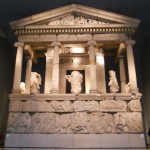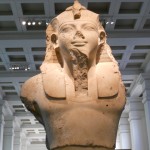The British Museum. Bang. Zoomph! Woop. Boom! The biggest statues, the coolest marbles, the most languages per stone, a whole bunch of the Parthenon. Beowulf. The museum is like a pirate’s hoard. It is everything awesome that the Brits could find and lug back to their island, displayed in a massive ceiling’d amalgamation of rooms with entirely uncoordinated and impossible to follow numbers that follow no logical pattern. Doesn’t get much better than that. Cleopatra’s body is there! Things that just have no business being there are all just hanging out at the British Museum and it is like it’s no big deal. You wander through the museum, stumbling upon gigantic Egyptian and Greek statues portraying God’s and mythical battles.
This brings me to an interesting point that I am sure has been discussed throughout these blogs ad nauseum. It is this British idea that somehow these priceless objects belong in the British Museum and not, say, back in their respective countries of origin. I’ll refer here to a quote from a plaque in the Greek portion of the museum.
“The Parthenon sculptures in the British Museum were brought to England by Lord Elgin and bought for the Museum in 1816. Elgin’s removal of the sculptures from the ruins of the building has always been a matter of discussion, but one thing is certain- his actions saved them further damage by vandalism, weathering and pollution. It is also thanks to Elgin that generations of visitors have been able to see the sculptures at eye level rather than high up on the building.”
Okay, let’s ignore the last sentence as the Museum is clearly grasping at straws. Obviously, the sculptures could be at eye level in Greece. Instead I’d like to focus on the phrase ‘one thing is certain.’ So that is to say that it isn’t certain that the sculptures should be back in Greece. As if both countries have a legitimate claim to the sculptures and it is a matter of debate, instead of a simple matter of Britain not wanting to give the sculptures back.
The other museum that I found truly blog-worthy is called the Welcomme Collection. It was of interest for a number of reasons. First was simply the content. One of the major exhibits I explored was on medicine, exploring its history. But what really set this museum apart was the way it was presented. The first thing I saw upon walking into the exhibit was a massive plastic model of a person, entirely consumed by bulbous fat. It had no head or features besides legs. And then there was thorough analysis on the side. This wasn’t a museum designed to wow in the way the British Museum did. It was supposed to provoke thought. The exhibit pointed out how humans had evolved in an environment in which we had to walk considerable distances and could not eat very often. And that through technology we eliminated this need to walk while also increasing the availability of calorie-rich foods. And that many developments (such as a remote control, automatic can opener) were designed to remove any sort of exercise from day to day life. But at the same time, humans are inventing products such as stationary bikes to increase artificial exercise. In the next room I came upon three chairs in glass. Two were dentist’s chairs, one from 1900 and the other from before that. The third chair was a torture chair covered in blades and hooks from Ancient China. The plaque on the side did not explain the connection between the three, but it was a shocking exhibit all the same. The final thing of interest about the Welcomme Collection was the clientele. It was mostly young people, teenagers and mid-twenties, and a seemingly alternative culture. Girls with pink Mohawks and black leather jackets, that sort. Another really cool exhibit contained an actual metal chastity belt from centuries ago, which I did not realize existed.
These two museums are particularly interesting when juxtaposed. The British Museum needs no explanation. It’s exhibits are shockingly valuable and famous. The Welcomme Collection provokes thought and puts together interesting and obscure objects.



1 response so far ↓
Karl // Sep 23rd 2010 at 09:16
Glad to see you visited the Welcomme. It is a great collection. The post, however, would benefit from photos of it and links to both museums.
You must log in to post a comment.